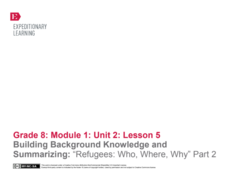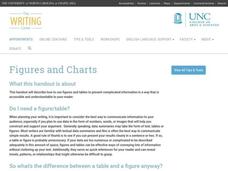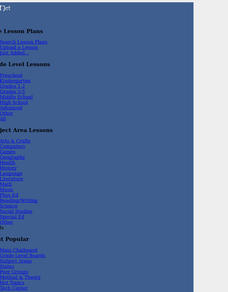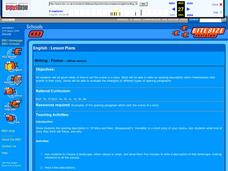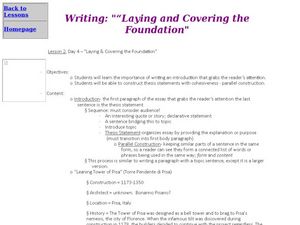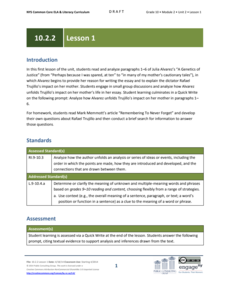Houghton Mifflin Harcourt
Nature Walk: English Language Development Lessons (Theme 2)
Walking in nature is the theme of a unit designed to support English language development lessons. Scholars look, write, speak, and move to explore topics such as camping, woodland animals, instruments, bodies of water, things found at a...
Roald Dahl
Matilda - Throwing the Hammer
Full truth, or an exaggeration? How can you tell when a storyteller is exaggerating a story? Readers analyze a story told by Hortensia, and identify the exaggerative language she uses. Then, learners write their own narrative story using...
EngageNY
Building Background Knowledge and Summarizing: “Refugees: Who, Where, Why” Part 2
What are some universal aspects of refugees' experiences worldwide and throughout history? Scholars read the text "Refugees: Who, Where, Why" and create two class anchor charts. Finally, they each write a paragraph that provides an...
EngageNY
End of Unit Assessment: Research Synthesis
Writers near the end of the unit and begin working on the end-of-unit assessment. They analyze the prompt and a model performance task. The class then begins creating a rubric for the assessment by writing bullet points from their think...
EngageNY
Close Reading: Paragraphs 2 and 3 of “Refugee and Immigrant Children: A Comparison” and Introducing the NYS Expository Writing Rubric
What factors make adaptation successful for refugee and immigrant children? The class explores the topic by reading two paragraphs from "Refugee and Immigrant Children: A Comparison." Next, they engage in a think-pair-share to discuss...
University of North Carolina
Figures and Charts
Sometimes words aren't the best way to get information across to the reader. The eighth handout in the 24-part Writing the Paper series describes different type of figures and charts to display complex information in a paper....
Curated OER
Writing-Forming Paragraphs
Fifth graders study how to form paragraphs. In this writing lesson, 5th graders discuss why it is important to have paragraphs in their writing. Students also explore the rules writers use to know where to begin a new paragraph and then...
Curated OER
Five Paragraph Essay
Students create a standard outline, using a word processing tool, while they are learning about the basic writing device of the 5 paragraph essay.
Project Noah
Writing Goes Wild
Young scientists develop their observation and writing skills as they craft and then post a detailed description of a plant or animal they have spotted and photographed.
Curated OER
Successful Paragraphs
Students write a five sentence paragraph with varied sentence beginnings. In this paragraph writing lesson, students use a teacher modeled procedure. They complete a worksheet about their favorite things, happenings, and places before...
Curated OER
Lesson Exchange: Introduction to Research Papers (Senior, Literature)
Although unlikely in today's English classroom, this lesson focuses on introducing research papers to seniors in high school. It briefly reviews the parts of an essay, and mentions showing learners example essays, but no examples are...
Curated OER
Strip-Teasers: A Collaborative Writing activity
Young writers engage in a fun writing activity. They write three different sentences on three strips of paper. Then they get into groups of three, and take a look at all nine sentences that have been written. Their task is to write a...
Curated OER
Writing About Time: My Favorite Times
Start by clicking on the icon that says, "Download the Activity." The format is much easier to read and understand here! Then, encourage your class to write about some of their favorite things through a three-paragraph essay. Examples...
Curated OER
Writing - Fiction
After listening to the opening description in Of Mice and Men, high schoolers try their hand at writing a short story that includes a mugging. The story should include all five senses. Each of the pupils reads their opening paragraph to...
Curated OER
Using Color as a Pre-Writing Tool
To better understand how to compose a clear and well-organized paper, learners read short passages, write summaries, and make colored graphic organizers. This is a fully developed three-day lesson with suggested assessments.
Curated OER
Using the Senses to Write Descriptively
Students write descriptive paragraphs using adjectives based on the use of their five senses. They use sensory impressions to improve their writing.
Curated OER
Writing: Laying and Covering the Foundation
Your middle schoolers can become stronger writers with a lesson covering the basics. They compose effective thesis statements and introductions, discuss different ways to capture a reader's attention, and compare a poorly written...
Curated OER
Essay Writing: Components of an Essay
The multi-paragraph essay is the subject of a presentation designed for high schoolers. Color codes are used to highlight for viewers the different elements found in each paragraph. Unlike some presentations, the same essay is used...
Curated OER
Paragraph Writing-Using -ed in Regular Verbs
In this paragraph writing worksheet, students write a paragraph about different places they have lived, using a set of 4 given sample sentences that use verbs with "ed" endings.
Curated OER
Transition Words in Writing
Transition words in writing are the focus of the language arts lesson presented here. In it, learners cut out the word-sort cards (embedded in the plan), and put them into four categories: time, examples, space, and summary. They find a...
EngageNY
Grade 9 ELA Module 3, Unit 3, Lesson 3
Plagiarism is the theft of intellectual property. To avoid this crime, class members learn how to create a works cited page and how to craft in-text citations. After examining a high-performance model paragraph and an example of a works...
EngageNY
Grade 10 ELA Module 2: Unit 2, Lesson 1
Rafael Trujillo was president of the Dominican Republic in the 1930s. Pupils read and analyze the first six paragraphs of Julia Alvarez's autobiographical essay "A Genetics of Justice," in which the author describes Trujillo's impact on...
EngageNY
Grade 10 ELA Module 2: Unit 2, Lesson 2
What is a megalomaniac? Scholars discover the word's meaning as they read and analyze paragraphs seven and eight from Julia Alvarez's essay "A Genetics of Justice." They also read Mark Memmott's article "Remembering to Never Forget" and...
Curated OER
Grammar - Revise Your Symbols
Explore the different symbols of grammar. Middle schoolers write two sentences using different symbols, including asterisks, apostrophes, and ellipses. They also read and answer guided questions.




